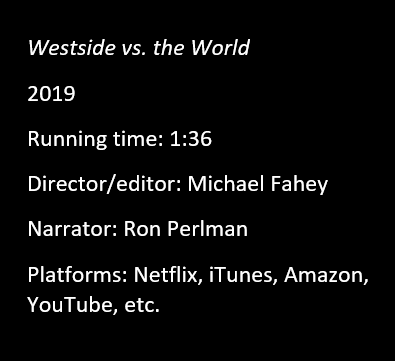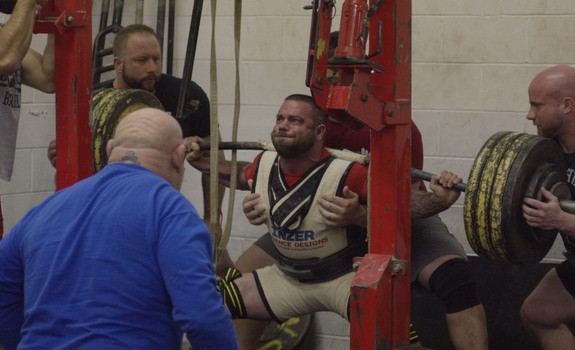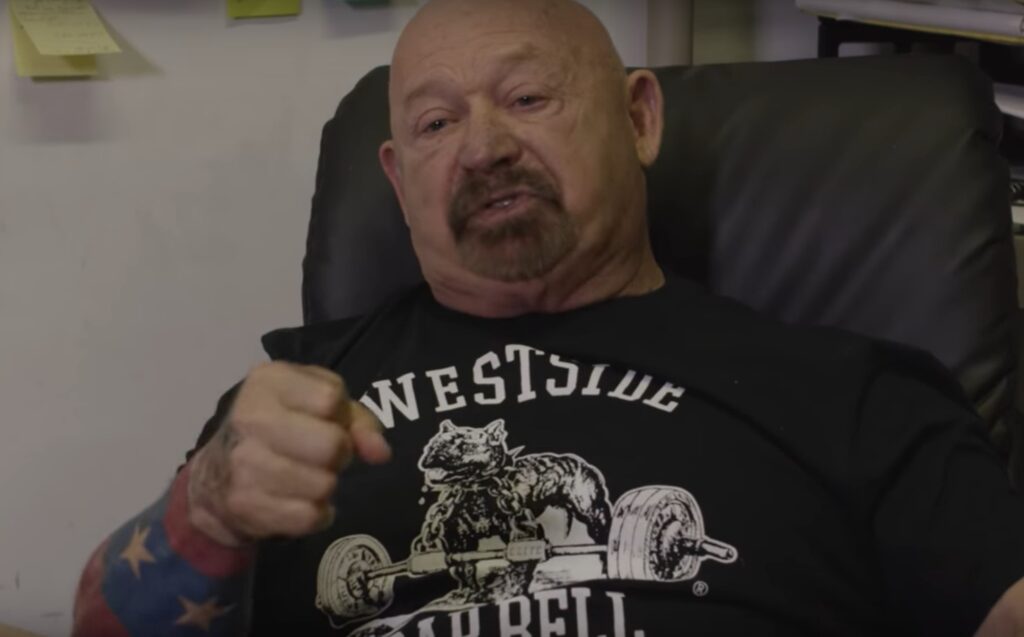Gravitas Ventures/Netflix
“There’s not a powerlifter on the planet that doesn’t know Westside Barbell.”
“They were like the crazies—a collection of lunatics with some f**king crazy strength, world record holder after world record holder.”
“I’ve seen a lot of guys come in; I’ve seen a lot of guys go out.”
“People don’t understand what a hardcore attitude you need to have in that gym.”
“It was go-time every time you walked through that door.”
“Westside was a cult.”
“It was literally hell with weights.”

If the preceding collage of quotes, which comes near the beginning of Westside vs. the World, doesn’t make you want to hear and see more, then this documentary isn’t for you, because it dives deep into the five decades of drama and all around badassery of world-class powerlifters in the legendary Columbus, Ohio gym, Westside Barbell. Members are taught, tormented, and sometimes, in their opinion, betrayed by Westside’s owner, the Yoda of power, Louie Simmons.
A lot of drama also preceded the release of this film. Its original co-director and cameraman, out on bail last March after a drug-dealing arrest, emptied the production bank account. The movie’s greater creative force, Michael Fahey, successfully sued his former collaborator for full ownership but couldn’t recover the stolen money. All of this fostered delays and more fundraising. Many believed Westside vs. the World, previously much-hyped (“The Pumping Iron of powerlifting”) and supported by Kickstarter funders, was cursed to never materialize.
So, it’s a testament to co-producer/director/editor Fahey that not only is it now screening on Netflix, but it’s a terrific movie, especially for powerlifting fans.
2023 Update: It’s no longer on Netflix, but can be rented on Amazon, etc. Louie Simmons passed away in 2022 at 74.

WESTSIDE VS. THE WORLD: WEAKNESSES
• The biggest criticism of Westside vs. the World is that it spends too much time deep inside Westside—the disputes, bruised egos, and machinations—and not enough time on the World—how Louie Simmons’ techniques (chains, bands, the conjugate method, etc.) transformed strength training. It dips into the latter too briefly near the end when we see Simmons working with MMA fighters and other non-powerlifters, and throughout we hear from football coaches who sought out Simmons the sage. But what criticism have the methods faced? How exactly have the techniques been incorporated by programs and lifters outside Columbus? This was never meant to be a how-to lesson, but everything included about the Westside way is fascinating, and it left this viewer wanting more of the big picture and a bit less of the “reality TV” ego clashes.
• As great as it is to see any footage from the ’80s and ’90s, the quality of deteriorating VHS tapes makes some of it look like it was shot underwater. Also, you may sometimes strain to hear Simmons, whose twangy mumbles can be difficult to make out.

WESTSIDE VS. THE WORLD: STRENGTHS
• There’s a wealth of material here. Fahey should be commended for doing his due diligence, interviewing the famous and the forgotten, in and outside the Westside “gang,” including Ed Coan (who tears up in a surprising scene), Dave Hoff, Dave Tate, Laura Phelps, and Mark Bell. Interviewees talk candidly (and often f**kin’ profanely), telling stories never chronicled before, as if they’d been waiting to spill the beans. The rapid rise and fall of the late Matt Dimel is a tragic highlight. And there are delicious quotes throughout, like this one from Tony Ramos: “We’re f**king thoroughbred horses. If we break our leg, take us out back and f**king shoot us. That’s how it works.”
• The editing, music, and judicial use of animation are all first-rate. The film is especially well-paced. And it benefits from the baritone narration of actor Ron Perlman, of Hellboy and Sons of Anarchy fame.
• Then there’s all the badassery: the f**kin’ strutting, the f**kin’ cursing, the f**kin’ punches, the f**kin’ world record lifts. Even in small doses, this may be the ultimate pre-workout (or pre-set) psych-up to keep on your phone. It’s sort of the inverse of Pumping Iron, the cheery 1977 documentary that introduced bodybuilding and charismatic Arnold Schwarzenegger to the general public, and therefore Westside vs. the World won’t have a similar impact. Powerlifting ain’t bodybuilding, so this is a much darker tale. Whereas sunny P.I. seduces with joy and comradery on and near California beaches, gray WvW smacks you with pain and conflict in a windowless pit in the Rust Belt. Buckle-up and get under a bending bar, now!
• In two words: Louie Simmons. What a character! Every moment he’s onscreen is captivating, and he’s onscreen a lot, dispensing wisdom, celebrating what was and lamenting what could’ve been, and baring his tortured soul. “What else have I got?” he asks the camera near the end, going all Moby-Dick about his need to lift heavy things. “I’m hooked onto that white whale. I got nowhere else to go. What else am I going to do? I’m gonna go down with that white whale. He’s gonna drag me to the bottom eventually. And I don’t care; that’s what I want.”















































